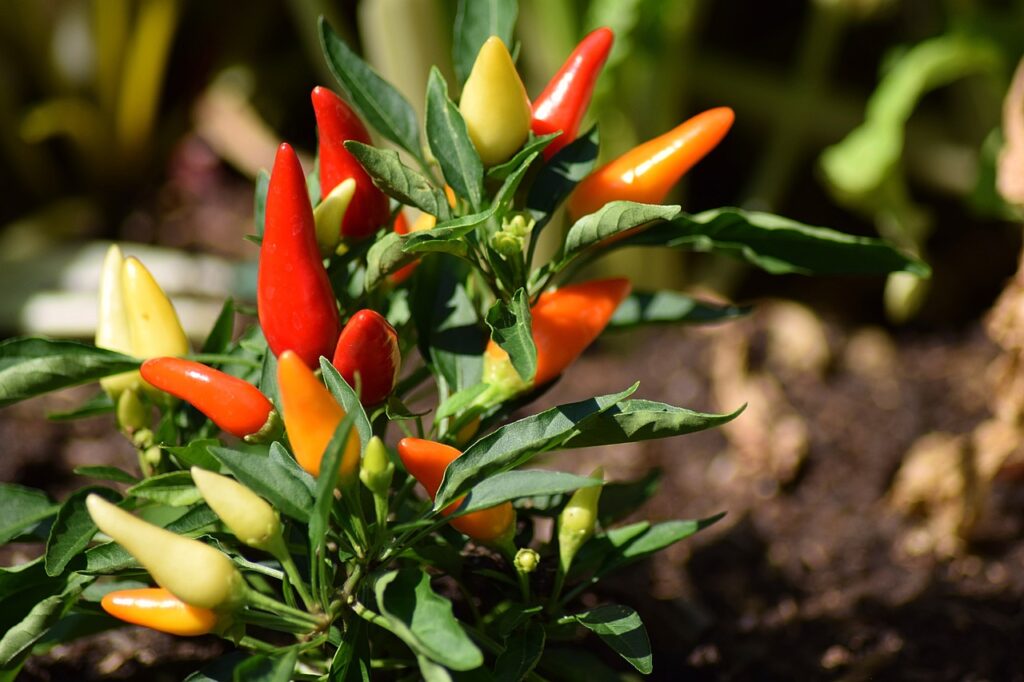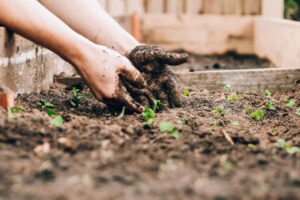
Chillies are an incredibly versatile fruit and very easy to grow. They tend to have a bit of a ‘Marmite’ following with definite fans made up of those who enjoy spicy foods and those who don’t. This is because many people don’t understand that chilli varieties range from very gentle, sweet fruits up to the extremely hot. In fact, most people won’t appreciate that the humble bell pepper is in fact a chilli, and paprika flavouring comes from chillies too. So if you’re thinking about growing chillies, do some homework and choose varieties which are likely to appeal to you and your family; there are hundreds out there!
How is chilli heat measured?
Chilli heat is measured on the Scoville chart with 0 the lowest (found in the bell pepper/capsicum). The hottest have a Scoville rating in the millions, again proving the vast range across varieties. Most of the chillies sold in supermarkets will have a rating between 0-200, so are very mild, sweet and smoky. The Jalapeno pepper is quite a popular mainstream chilli that most of us will have heard of with a Scoville sitting in the 2,000 – 8,000 range. Habaneros sit in the hundreds of thousands whilst well-known varieties including the Naga and famous Carolina Reaper sit at the top of the scale with Scoville ratings in the millions. Regardless of your propensity or tolerances, the good news is that all chillies are grown in pretty much the same way.
How to grow a chilli plant
The chilli is native to hot and dry climates so if you’re thinking of growing your own, bear this in mind. You need to, as best you can, recreate those same climates. That means hot, relatively dry and arid conditions during the day, and staying warm overnight. So chillies are best grown in greenhouses or indoors on south-facing windowsills where you can maintain temperature and conditions.
Chillies grow from seed – the same seeds that hold the heat – and getting started really is as simple as being able to plant dried seeds from a chilli to grow another plant. But if you want more guarantee that they will germinate and grow strong, find a suitable seller to supply the seeds. Whilst you could use seeds from a supermarket chilli, the reality is most are sold as generic red/green chillies leaving you with no idea about the Scoville rating or what they will produce. If you want to pick a particular type it’s best to buy directly from chilli seed suppliers or online seed suppliers.
How long does it take to grow a chilli plant?
The speed of germination and growth of a chilli plant will, like most seeds, rely on you getting the growing medium and environment right. Chillies don’t need anything out of the ordinary by way of soil – commercial growers of peppers and chillies grow the established plants in something similar to Rockwool insulation – and so a good quality multipurpose compost will be fine. The key thing to ensure is that it drains well – remember chillies like it arid.
Once you’ve germinated your seed and grown a plug plant, keep potting it up but wait until the roots are touching the side of the container each time. An established chilli plant won’t need much more than a 6”/15cm diameter pot for its main growth period. Terracotta pots are great for chillies as they retain the warmth and allow good drainage too.

When to plant chillies
Sow your seeds at the same time as your other summer crops in the spring when the temperature evens out and by June you’ll have a healthy chilli plant.
In early July you’ll have some fruits developing off their hanging flowers – they do not need any help pollinating. Then it’s just a case of allowing the chillies to grow and absorb the warmth. You want to maintain that fine balance between enough water to keep the plant healthy and not allowing it to dry out completely or wilt. Never stand the pot in water; a good weekly watering in most cases will suffice.
If you’re growing in a greenhouse, maintain the airflow to avoid absolute maximums of temperature. The fruits will use the water to flesh out and your fruits will typically be fully developed in August – but now is the time to wait as this is the crucial period when the chilli builds its heat. The longer you can keep them on the plant, the hotter they will become, absorbing the late summer heat, turning it into flavour.
Depending on the variety, the colour will change from green to red, yellow or orange. Whilst you can of course pick chillies from the moment they are fully developed, they come into their own around late August or early September giving them that warming mix of spice, sweetness and heat.

Using and storing your chillies
Like all crops in the garden, chillies tend to offer you up an abundance of fruits over a relatively short period. Having spent the summer growing, the fruits will be ready in the early autumn – perfect timing for making some more warming dishes as the evenings draw in and that autumnal nip returns.
Even if you’re a big chilli fan, the reality is you’re probably not going to be eating these for breakfast, lunch and dinner. The risk of a glut means the fruit could go over and spoil, and after all your hard work no one wants that! So if you’ve got a bountiful harvest of hot sweet chillies, here are some ideas for using them:
Freezing chillies
Chillies are really easy to freeze. If you want to have them easily on hand, to pick out and chop into a meal or onto a pizza, then take the chillies, give them a wash, pat them dry and pop them in a zip-lock bag in your freezer. If you’ve got some hot varieties which just need a small amount then simply slice it up and freeze the slices. Again, you can just pick out what you need, add to your meal, and enjoy using exactly what you need without anything going to waste.
Drying chillies
Drying chillies is as simple as freezing them. Take each chilli and using a needle and cotton or a length of fishing line, thread your chillies one by one to create a tress. If you can, thread through the flesh immediately underneath the stalk. Then hang the tress in your airing cupboard or somewhere where there will be constant warmth, ideally above room temperature.
Conservatories can work, but remember that in the autumn they may experience extremes of hot and cold as the nights cool off – which won’t allow the chillies to dry at an even rate or develop the sweetness.
Once your location is right and your tress is in place, your chillies will be ready after a few weeks. Either keep them in their tress in the kitchen, whole in a jar or put the batch into a blender (stalks removed but otherwise whole) and blend them up to make chilli flakes.
Make chilli jam/paste
Whilst the methods above allow for the use of chillies in other recipes or sprinkled on top of other food, you could always use chilli as the star ingredient. Simple chilli jam or chilli paste is straightforward to make and there are plenty of recipes to follow online. Using this method leaves you with a delicious sweet and spicy topping that acts as a perfect condiment, spread on crackers or stirred through sauces, allowing you to add as much or as little as your personal tastes dictate.
Good luck with your chilli growing! If you need any supplies, Earth Cycle has all the compost and gardening accessories you might need such as seed trays and hand trowels.



